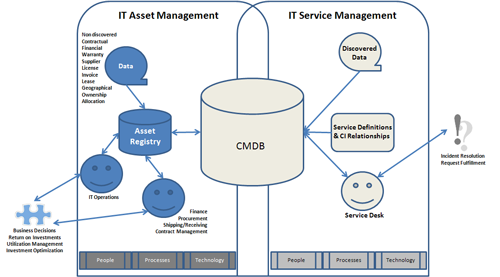ITAM: A Prerequisite for Building a CMDB (Part 2/6) – “The Link between ITAM and ITSM”
This article series has been contributed by Peter Salfi at Provance.
In this series Peter explains why an Asset Registry, created within an IT Asset Management program, comprised of the appropriate mix of people, process and technology, is often an overlooked prerequisite to creating a CMDB.
It describes a less painful approach to creating a reliable and accurate CMDB that allows organizations to realize a high return on their investment in time, effort and expense.
- PART 1 – Introduction – “Houston, We Have A Problem!”
- PART 2 – The Link between ITAM and ITSM
- PART 3 – 4 Reasons Why ITAM is a Prerequisite for a CMDB
- PART 4 – Why Building a CMDB is challenging
- PART 5 – Summary of Comparisons – ITSM vs. ITAM
- PART 6 – Conclusion – “Back to the Apollo 13 Story”
Part Two – The Link Between ITAM and ITSM
Fundamental to ITIL and IT Service Management (ITSM) is the establishment of a CMDB (Configuration Management Database). The CMDB serves as the definitive trusted source for all IT information required to provide effective, efficient and economical delivery of IT Service Management. The CMDB captures IT assets as “Configuration Items” or CIs, and defines the relationships between them to provide an IT Service. For example, servers, software, network and infrastructure are CIs that combine to provide an e-mail service.
Configuration Management is an organizational program for managing CIs and the CMDB. The people, processes and technologies that comprise Configuration Management ensure that the CMDB supports the Service Management function with a complete, comprehensive and consolidated set of data. As implied by ITIL, Asset Management is part of an overall Configuration Management strategy.
The Service Desk acts as the central point of contact between users and IT Service Management; it is the “face” of IT to the rest of the organization. The primary purpose of the Service Desk is to resolve incidents as quickly as possible and to minimize their impact on the organization. For this, the Service Desk relies heavily on the CMDB to understand how both planned and unplanned changes to a particular CI may impact a service. This is accomplished by understanding the relationships between assets. To provide both technically- and cost effective resolutions, the Service Desk also needs access to contractual, financial, warranty, supplier, license, lease, geographic, ownership and assignment details. For the CMDB to deliver against its intent, it cannot just contain detail about assets discovered through automation (i.e. through configuration scanning or “discovery” technologies). It must also include the assets and relevant asset information found only in the Asset Registry, i.e. the assets and information that cannot be provided by automated discovery processes, such as assets that are not connected to a network or contract details contained in this series.
Continues….
Read Part Three: ‘4 Reasons Why ITAM is a Prerequisite for a CMDB’.
This article series has been contributed by Peter Salfi. To find out more about Provance IT Asset Management for Microsoft System Center visit Provance.
Related articles:
About Martin Thompson
Martin is also the founder of ITAM Forum, a not-for-profit trade body for the ITAM industry created to raise the profile of the profession and bring an organisational certification to market. On a voluntary basis Martin is a contributor to ISO WG21 which develops the ITAM International Standard ISO/IEC 19770.
He is also the author of the book "Practical ITAM - The essential guide for IT Asset Managers", a book that describes how to get started and make a difference in the field of IT Asset Management. In addition, Martin developed the PITAM training course and certification.
Prior to founding the ITAM Review in 2008 Martin worked for Centennial Software (Ivanti), Silicon Graphics, CA Technologies and Computer 2000 (Tech Data).
When not working, Martin likes to Ski, Hike, Motorbike and spend time with his young family.
Connect with Martin on LinkedIn.


